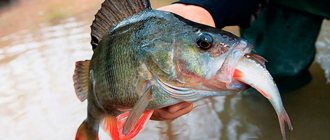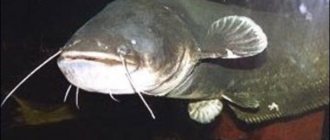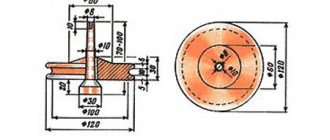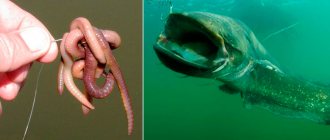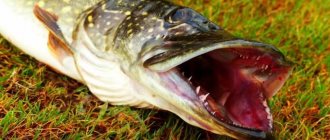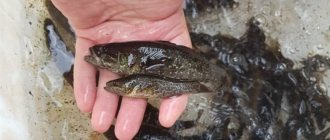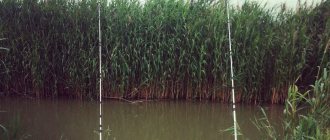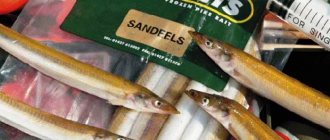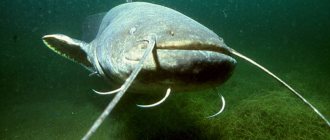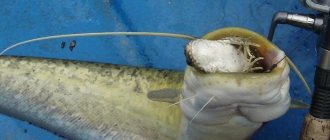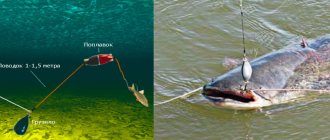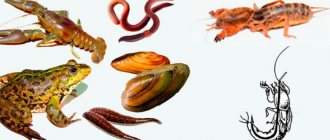Optimal time
Like any other fish, catfish are active at certain times of the year.
It is then that predators begin to actively move in search of food, looking for the most convenient habitats and undercuts where small fish accumulate. After going through puberty, catfish stop loving the sun's rays. Their priorities regarding their habitat change. As adults, catfish search for deep areas with sandy soil. In small rivers, catfish prefer to hide in the grass, even if the thickets of plants are located close to the shore. By the way, catfish traditionally look for a ready-made habitat created by the flow of water. But if necessary, they can make their own “housing” themselves. They also make caves in the ground. Quite rarely, catfish with a sedentary lifestyle can be found in hydraulic pipes. According to experienced fishermen, the most productive period is considered to be from late summer to early autumn. That is why at the end of August you can meet many people on reservoirs who want to try their luck in catching a trophy specimen. Donka is an important tackle for catching catfish in the spring, especially in May. The coolest place during this period is considered to be the exit from the pit where the fish lived in winter. But it is best to wait until the water in the reservoir warms up. The catfish will start cruising around the reservoir, which means it will probably get hooked. Fishermen claim that catching catfish in the summer is considered the most exciting activity. They are in constant tone, do not notice either fatigue or time. But the most important thing is that all their efforts are rewarded with an excellent catch.
In summer, catfish are found not only in the depths, but also in the shallows, which is why fishermen have an increased variety of places to fish. However, the best is traditionally considered to be a quiet pool. In the evening, catfish are especially active. As soon as the sun goes below the horizon, predators appear right on the surface of the water, creating noisy splashes. Ideally, summer catfish fishing should be done at night. You should use a frog or a small fish as bait. It is worth using several fishing rods, hanging a different bait on each hook. If you didn’t manage to catch a catfish on the first night, but managed to find its trail, don’t be upset. Having memorized its passages, subsequent night fishing will certainly be successful.
However, with sudden temperature changes and pressure changes, the biting stops. Catching a catfish in such conditions is a real miracle. Catching catfish in the fall is very simple and very interesting. The weather is appropriate, the predator feels excellent, leads an active lifestyle and even rises to the surface of the water. And if it becomes cloudy, he tries not to leave his home and looks for food there.
In the autumn period of the year, it is very difficult to determine the location of catfish. Therefore, you will have to look for a predator with the help of other fish, for example, carp or bream. Where there are a lot of them, there will probably be a catfish waiting nearby. The autumn bite is also affected by the fishing location. It’s better to throw the donkey into holes than to wait for a predator in shallow water. A good time for autumn fishing is early in the morning. The maximum silence of nature increases the chances of catching a large catfish.
Experienced fishermen, in turn, have drawn up a schedule for catching catfish on a donk, calculated for the entire period of activity of the predator.
- In April, the predator wakes up from hibernation. He begins to hunt and get food. This is a good time for catching catfish on a donk.
- At the beginning of May, the catfish leaves for spawning, and accordingly, its fishing stops.
- At the end of spawning, the predator becomes active. A bottom fishing rod will help you catch catfish of any size.
- The entire summer period is the time for catfish activity. In July, especially in the evening and at night, is the most favorable period for fishing both from a boat and from the shore.
- After mid-September, the catfish bite decreases as the predator begins its migration period.
- From November to March, fishermen should forget about catfish, as they are in hibernation.
Bait
When choosing bait for such fishing, it is worth considering that the predator has poor eyesight. But due to poor eyesight, its other senses are well developed - smell, hearing and sensitive sides, which allow the predator to sense water vibrations. A simple conclusion follows from this that it is necessary to choose bait that has a smell, or one that moves.
Many years of experience have shown that catching live bait from the shore can bring a trophy if you use live bait as bait (pike perch, pike, sabrefish or herring are suitable). And the frog should not be underestimated; it can also attract a mustachioed predator. Crayfish meat is also an excellent bait.
Very often you can see a locust or mole cricket impaled on a hook. Fishermen use the meat of large pearl barley a little less often, due to its inaccessibility. You can also try hooking pieces of meat, mice and birds. A bunch of large worms or caterpillars works great.
Catfish fishing with a variety of baits, the list of which can be continued endlessly. It is best to ask advice from experienced fishermen who have been fishing in your pond for more than one year. Also, don’t forget about experimentation and the fact that big catfish love big bait.
Transportation
Delivery of live bait for fishing is also associated with a number of difficulties. If a pond with a predator is within walking distance, then live bait can be brought in an ordinary bucket. If live bait for fishing is caught in the same body of water where the predator is to be hunted, then it can be stored in a fine-mesh cage lowered into the water. This method is especially suitable for fishing from a boat.
A bucket is not suitable for delivery by car; you need a special container - a can for live bait. It must ensure the safety of live bait: protect the water from splashing and, if possible, maintain the optimal water temperature for the time of year.
Although live bait cans can be bought at any self-respecting fishing store, many fishermen try to make them at home with their own hands. They are made from plastic cans or foam, old pots or cans, and other suitable materials. Winter containers are additionally insulated with foam rubber, foil insulation or polystyrene foam.
In spring and summer, the live bait can is additionally equipped with a compressor, which runs from a car cigarette lighter or from a battery.
If you need to transport or store a large amount of live bait in a pond, plastic barrels with a volume of 50-60 liters are perfect. To transport live bait, the barrel must be equipped with one or even two aerators.
At the fishing site, we replace the lid of the barrel with a net or gauze, which can be secured with an elastic band or rope, and place a weight on the bottom of the barrel. Gauze or mesh is needed to renew the water and keep the bait longer. We tie a rope to the barrel so that it is convenient to lift it later and immerse it in the water. In winter, through a specially made ice hole. In summer, it is better to immerse the barrel under water in a shady place, and attach the rope to a driven stake.
Carefully attach the gauze and rope to the barrel. It’s not a new thing when, due to carelessness, fishermen were left without live bait and the fishing plan collapsed all at once. Don't forget to take spare batteries when fishing!
Secrets of catching catfish on a feeder
There are plenty of tricks for hunting river barbel using a hook feeder. But for every fisherman they are associated with details, nuances, and personal know-how.
It makes sense to list a few basic wisdom that will be useful to fishing beginners:
- The predator likes to live in holes, at the bottom of the river, where there are plenty of snags and other driftwood. In search of food, it begins to circle near its habitat and then rises with the current.
- Fishing on a feeder within a snag is not advisable. It is more effective to fish for giants near changes in depth, reaches, and edges.
- You can catch the predator in April when the water temperature is 8 °C. But the best time to hunt for barbel is July-August, when the activity of the representatives of ray-finned fish of interest reaches its peak.
- The feeder's chance of putting large, medium-sized catfish into a large bag will increase slightly if he starts fishing in the summer heat, in the morning or evening hours.
- Thunderstorms and increased atmospheric pressure are unfavorable factors for capturing the owner of the river depths. In bad weather, he hunts near the bottom away from the shore.
Today, modern feeder gear is the optimal solution for river catfish fishing. The methods of catching catfish are not the same, it makes sense to briefly mention equipment and food. You need to choose durable, reliable gear in order to feel confident at a crucial moment. Before fishing, it is advisable to examine the bottom of the reservoir with an echo sounder in order to find depth differences and the presence of thresholds. Other promising places for hunting predators are strong currents and river bends.
Catching pike perch with live bait
A novice fisherman, before starting to prepare for catching pike perch using live bait, needs to become familiar with the advantages and disadvantages of this method. After all, for some personal reasons, this type of fishing may not be suitable.
Advantages:
This method is more effective than using a spinning rod
It is good when the pike perch behaves cautiously, since natural prey causes less doubt in it - the predator will be more willing to attack it. You can fish with live bait using several gears at once, which significantly increases the chances of getting a trophy. Fishing with live bait is a passive activity, which allows the angler to relax in nature or read his favorite book. Disadvantages:
Flaws:
- The trouble with choosing this method is fiddling with live bait. Experienced fishermen have repeatedly noticed that when the need arises to catch fry, they immediately disappear from everywhere. This is why you should take care of this problem in advance.
- To keep the fry alive, you need a large container of water and a cool place (a basement or cellar is perfect).
- In a large water area, to successfully catch pike perch, you need a boat. It is especially necessary in the autumn, when the predator prefers to accumulate in the riverbed edges away from the coastline.
What is better to use - fry or sprat?
A notable feature of this predator is that it feeds only on live fish, so there is a need to use only the most active and viable bait as bait, which will definitely attract attention. In those reservoirs where a large number of fry live, it is better to use it, as it is a tasty prey for pike perch
An alternative to such bait is sprat. It is used during bottom fishing, and, as is known, this fish hunts only in the lower part of the water body
In those reservoirs where a large number of fry live, it is better to use it, as it is a tasty prey for pike perch. An alternative to such bait is sprat. It is used during bottom fishing, and, as is known, this fish hunts only in the lower part of the water body.
Advice! You should always choose the largest individual for the role of live bait (up to 7 cm long), as it can attract a hefty predator.
Also, when storing live bait, you should pay attention to:
- What type of fish does it belong to (if it is a bottom fish, then it will live longer, but if it is a surface fish, then there is a high probability of death in conditions outside the reservoir).
- It is worth periodically changing the water in which the bait is located. In addition, it is necessary to clearly monitor the oxygen level in the water (if the fish is at the surface and takes in air with its mouth, it’s time to change the water).
- Make sure that the water has a temperature of 15–20 degrees.
- Do not place a predator with regular fish in the same vessel.
- The container containing the live bait must be placed in a dark place (if it is very hot outside, it must be additionally covered with a wet cloth).
How to properly place live bait on a hook
Hooking methods:
- For the tail section. This is the easiest method, which implies that the hook will be inserted into the body at the tail.
- Behind your back. This method is most suitable for bottom fishing, as it avoids the fishing line getting caught on snags and other debris. When attaching, you should remember that the hook must be hooked to the skin and you must avoid damaging the spine, as the bait will quickly die because of this.
- Per head. This method is best suited for bodies of water with fast currents. The hook is directly attached to the lips or nostrils (the sting of the hook comes out either through the cheek or through the gill cover).
In addition, there is another quite popular method that does not damage the bait at all. It consists of purchasing a special thread with which the fry will be tied.
Advice! When baited, large hooks severely injure live bait. Therefore, experienced fishermen use medium and small sized gear.
When the bait is attached to one hook, the fry will receive much more damage than if it were attached to two stings at the same time. Then the live bait will be less active, but it will remain viable for a much longer period of time.
Lure
If little-known bodies of water are chosen for fishing, the number of fish caught can be increased with the help of bait. After all, old, large-sized individuals are cunning and rarely swim out of snags.
Catfish are lazy predators and prefer food of animal origin:
- Intestines of birds and animals.
- Carcass parts.
- Bird offal.
- Pieces of bird skin.
Catfish emerge from the snags of their own free will if the pieces are smoked or fried before scattering so that the smell is strong.
Sometimes, for bait, pre-roasted bird feathers rolled into lumps of clay are scattered along the bottom. To enhance the aroma, fish oil is added to them. All types of complementary foods should be provided about a day before fishing.
How to hook live bait on one hook
The basic requirements for a live bait hook are as follows:
- The hook must be very sharp and made of high-quality material.
- The number of stings on a hook can be from one to three. They are chosen depending on the method of attaching live bait.
- Hooks must have a long shank.
- Hooks should be as thin as possible. This way they will injure the live bait less.
- To attach small live bait, twin (not double) hooks should be used.
- Hook sizes depend on the length and weight of the baitfish. Usually hooks with numbers from six to twelve are used.
- To catch large fish, hard forged hooks should be used.
- It is better to use hooks from branded manufacturers who guarantee the quality of their products.
The advantages of a single hook include the following:
- This type of hook is easier to handle than a double hook.
- Live bait has the ability to move more, the better it attracts fish.
- Live bait on one hook swims more naturally, since it clings to just one point.
The disadvantages include the following: Careless use of one hook often injures the fish too much, and it quickly dies in the water.
- The fish is less likely to get caught than on two hooks.
There are the following methods for placing live bait on one hook:
Live bait by the lips
Used as a catch with general tackle together with a sliding weight or with a drop shot. You can also use this method to make a bait for fishing with a jig.
This method is performed as follows:
- First you need to insert the hook through the lower lip of the baitfish, and then through the upper.
- The hook must be turned with the tip up so that the baitfish can move while in an upright position.
The main disadvantage of this method is that by threading both lips of the bait fish, the fisherman completely blocks the flow of water into his mouth and its exit through the gills, so the fish simply dies.
Live baits that have been placed in this manner should be checked frequently and replaced with new ones if they no longer move.
Live bait attachment behind his back
This method is recommended for fishing in a body of water with a quiet current, as well as for fishing on a girder.
This attachment is carried out as follows: Pass the hook onto the dorsal fin of the baitfish in such a way as not to injure its muscle covering.
The advantages of using such a nozzle include the following:
- The bait fish will swim very naturally, since nothing will interfere with it.
- Live bait will last longer than others and will not need to be replaced as often.
The disadvantages of this method include the fact that too active baitfish can break out of the hook and escape. In addition, if a fisherman damages the fish’s spine when hooking it, it will become motionless in the water.
Live bait attachment by the tail
It is used in cases where fishing occurs without additional cargo. This method is also recommended for those fishermen who catch fish without a float or fish in thickets.
It is performed this way:
Insert the hook through the lower part of the baitfish (its tail area). Bring the tip of the hook out so that it is clearly visible.
The advantages of this method include that the live bait feels free, since there is no weight on it, and this allows it to move. The disadvantages are that live bait swims upside down, which does not always attract fish.
How to properly bait through the gills?
The hook is immediately equipped with a leash, but there is no need to install unnecessary accessories; it is better to place the carabiner and swivel on the base. This element of equipment should be wound through a leash; it is passed through the mouth and brought out under one of the gill covers, and then fastened to the base.
Tricky way
All previous methods of attaching live bait injure it to one degree or another, but the cunning one completely eliminates this. Its essence lies in the fact that in the area of the tail, an ordinary rubber band is put on the body of the live bait, and the hook is placed directly under it.
Live bait equipped with this method lives much longer, while remaining as active as possible for a long time.
Insert the hook into the live bait and in the area of the dorsal fin; a more experienced fisherman can handle this
With this method, it is important not to hit the spine or other vital organs.
